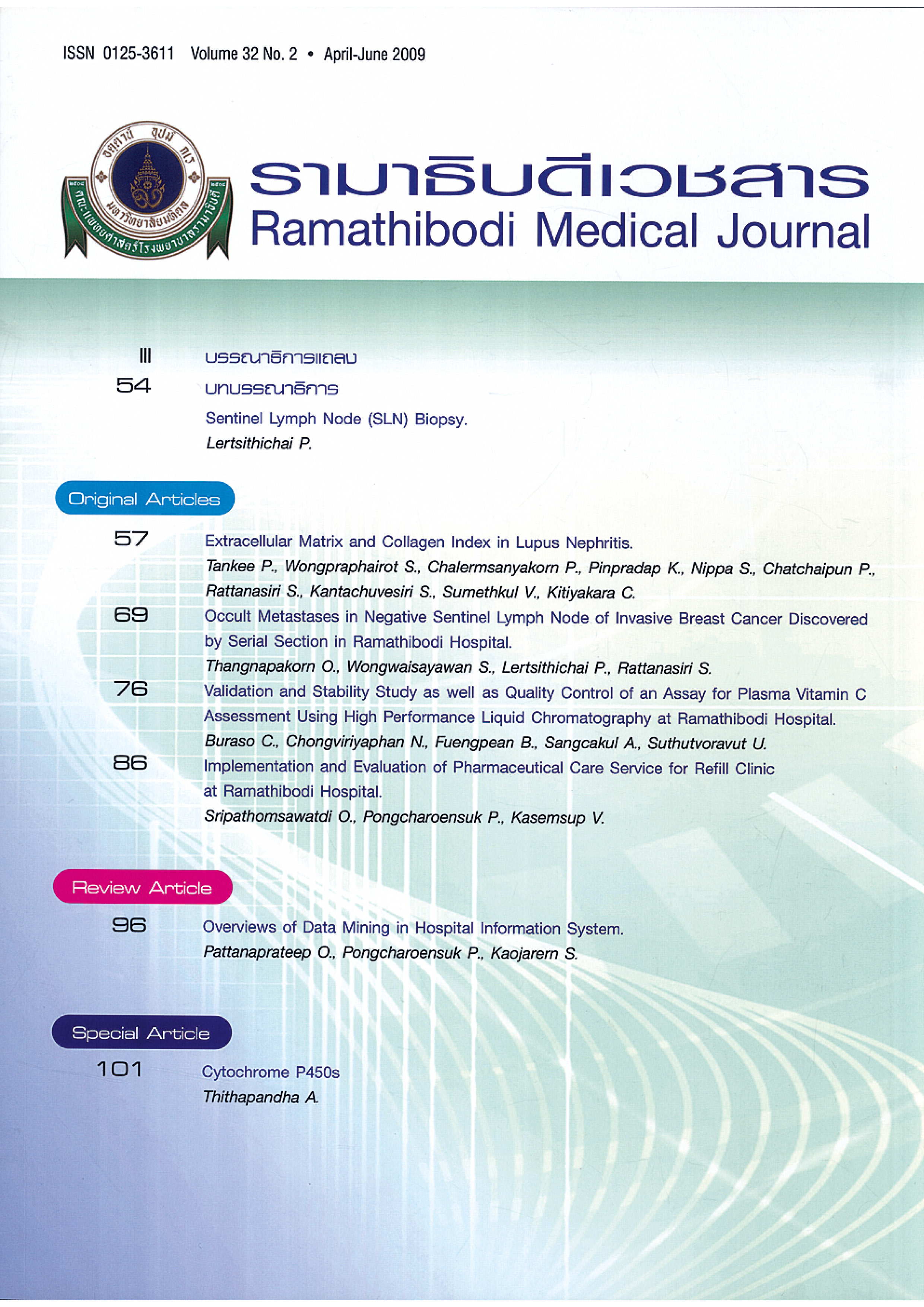Extracellular Matrix and Collagen Index in Lupus Nephritis
Main Article Content
Abstract
Background: Interstitial fibrosis is associated with poor long term outcome in many kidney diseases. We investigated the predictive value of extracellular matrix quantification on long term outcome in patient with lupus nephritis.
Methods: A cohort of 43 patients with lupus nephritis (LN) was followed from the time of biopsy. Kidney biopsy specimens were stained with picro-sirius red. The magnitude of fibrotic tissue was calculated by computerized image analysis. Each biopsy tissue was evaluated for different parameters: collagenous matrix index (CMI), fibrillary collagen index (FCI), activity index and chronicity index.
Result: At baseline, median serum creatinine(Cr) was 0.8 mg/dl and mean eGFR was 90.3 ± 37.6 ml/min/ 1.73 m2. Median follow up was 56.4 (range 1.2 - 13.2) months. Thirty-three patients achieved remission (22 complete remission, 11 partial remission), 20 patients had decreased 25%eGFR, 6 patients had renal failure (dialysis, eGFR<15 or Cr >5) and 9 patients died. At the time of biopsy, the activity index correlated with Cr, eGFR and proteinuria. Chronicity index correlated with Cr and eGFR. CMI correlated with Cr and tended to correlate with eGFR. Low CMI predicted good long term renal outcome as assessed by 25% decreased eGFR, renal failure and death. Low activity index was associated with earlier remission. The activity index, chronicity index and FCI predicted of long term renal outcome.
Summary: A computerized system for extracellular matrix quantification of LN predicts long term renal outcome. Future studies are necessary to determine benefit.
Article Details
References
Shayakul C, Ong-aj-yooth L, Chirawong P, et al. Lupus nephritis in Thailand: clinicopathologic findings and outcome in 569 patients. Am J Kidney Dis. 1995:26:300-7.
Houssiau FA. Management of lupus nephritis: an update. J Am Soc Nephrol. 2004;15(10):2694-2704. doi:10.1097/01.ASN.0000140218.77174.0A.
Mittal B, Rennke H, Singh AK. The role of kidney biopsy in the management of lupus nephritis. Curr Opin Nephrol Hypertens. 2005;14(1):1-8. doi:10.1097/00041552-200501000-00002.
Eikmans M, Baelde HJ, de Heer E, Bruijn JA. RNA expression profiling as prognostic tool in renal patients: toward nephrogenomics. Kidney Int. 2002;62(4):1125-1135. doi:10.1111/j.1523-1755.2002.kid566.x.
Myllymäki JM, Honkanen TT, Syrjänen JT, Helin HJ, Rantala IS, Pasternack AI, et al. Severity of tubulointerstitial inflammation and prognosis in immunoglobulin A nephropathy. Kidney Int. 2007;71(4):343-348. doi:10.1038/sj.ki.5002046.
Rush PJ, Baumal R, Shore A, Balfe JW, Schreiber M. Correlation of renal histology with outcome in children with lupus nephritis. Kidney Int. 1986;29(5):1066-1071. doi:10.1038/ki.1986.108.
Grimm PC, Nickerson P, Gough J, McKenna R, Stern E, Jeffery J, et al. Computerized image analysis of Sirius Red-stained renal allograft biopsies as a surrogate marker to predict long-term allograft function. J Am Soc Nephrol. 2003;14(6):1662-1668. doi:10.1097/01.asn.0000066143.02832.5e.
Pape L, Henne T, Offner G, Strehlau J, Ehrich JH, Mengel M, et al. Computer-assisted quantification of fibrosis in chronic allograft nephropaty by picosirius red-staining: a new tool for predicting long-term graft function. Transplantation. 2003;76(6):955-958. doi:10.1097/01.TP.0000078899.62040.E5.
Levey AS, Eckardt KU, Tsukamoto Y, Levin A, Coresh J, Rossert J, et al. Definition and classification of chronic kidney disease: a position statement from Kidney Disease: Improving Global Outcomes (KDIGO). Kidney Int. 2005;67(6):2089-2100. doi:10.1111/j.1523-1755.2005.00365.x.
Kubista M, Andrade JM, Bengtsson M, Forootan A, Jonák J, Lind K, et al. The real-time polymerase chain reaction. Mol Aspects Med. 2006;27(2-3):95-125. doi:10.1016/j.mam.2005.12.007.
Sweat F, Puchtler H, Rosenthal SI. Sirius Red F3BA as a Stain for Connective Tissue. Arch Pathol. 1964;78:69-72.
Pickering JG, Boughner DR. Quantitative assessment of the age of fibrotic lesions using polarized light microscopy and digital image analysis. Am J Pathol. 1991;138(5):1225-1231.
Moragas A, Allende H, Sans M, Vidal MT, García-Bonafé M, Huguet P. Cirrhotic changes in livers from children undergoing transplantation. Image analysis. Anal Quant Cytol Histol. 1992;14(5):359-366.
Moreso F, Gratin C, Vitriá J, Condom E, Poveda R, Cruzado JM, et al. Automatic evaluation of renal interstitial volume fraction. Transplant Proc. 1995;27(4):2231-2232.
Moreso F, Serón D, Vitriá J, Grinyó JM, Colomé-Serra FM, Parés N, et al. Quantification of interstitial chronic renal damage by means of texture analysis. Kidney Int. 1994;46(6):1721-1727. doi:10.1038/ki.1994.474.
Hunter MG, Hurwitz S, Bellamy CO, Duffield JS. Quantitative morphometry of lupus nephritis: the significance of collagen, tubular space, and inflammatory infiltrate. Kidney Int. 2005;67(1):94-102. doi:10.1111/j.1523-1755.2005.00059.x.
